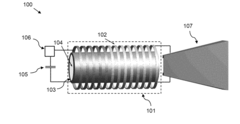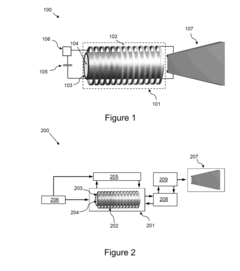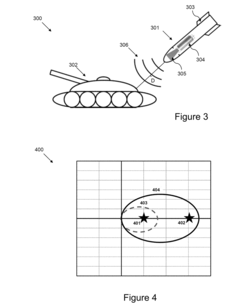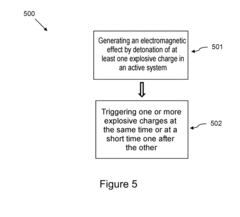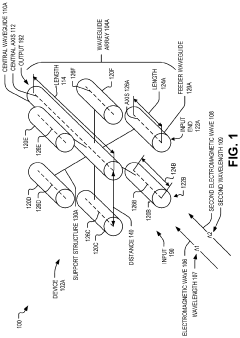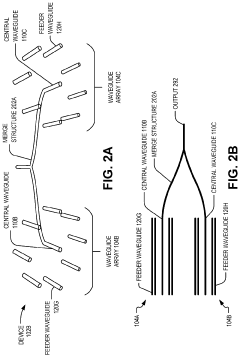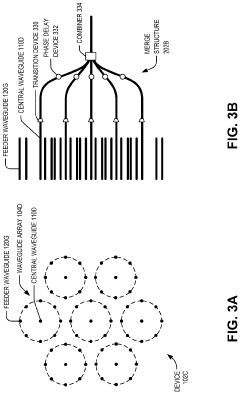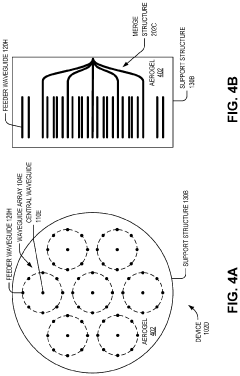Electromagnetic Waves in Defense Technology: Current Trends
JUL 11, 20259 MIN READ
Generate Your Research Report Instantly with AI Agent
Patsnap Eureka helps you evaluate technical feasibility & market potential.
EM Defense Tech Evolution
The evolution of electromagnetic (EM) waves in defense technology has been marked by significant advancements and paradigm shifts over the past century. Initially, the military applications of EM waves were primarily focused on radio communications and radar systems. The development of radar during World War II revolutionized air defense and naval warfare, providing crucial early warning capabilities and enhancing situational awareness.
In the post-war era, the focus shifted towards more sophisticated electronic warfare (EW) systems. These included jamming technologies to disrupt enemy communications and radar, as well as countermeasures to protect against incoming threats. The Cold War period saw rapid advancements in EM-based surveillance and intelligence gathering systems, including signals intelligence (SIGINT) and electronic intelligence (ELINT) platforms.
The advent of digital technology in the late 20th century brought about a new era in EM defense capabilities. Software-defined radios and cognitive EW systems emerged, offering unprecedented flexibility and adaptability in the electromagnetic spectrum. Concurrently, the development of stealth technology pushed the boundaries of radar absorption and deflection, fundamentally changing the nature of air combat and defense.
Recent trends in EM defense technology have been driven by the increasing complexity of the electromagnetic environment and the proliferation of advanced threats. Multi-function RF systems have become a key focus, integrating radar, communications, and EW capabilities into single, versatile platforms. This approach not only reduces the physical footprint of systems but also enhances interoperability and spectrum efficiency.
Another significant trend is the development of directed energy weapons, particularly high-power microwave (HPM) and laser systems. These technologies offer the potential for speed-of-light engagement of targets and the ability to counter emerging threats such as swarms of unmanned aerial vehicles (UAVs). Additionally, advancements in quantum sensing and computing are opening new frontiers in EM detection and secure communications.
The miniaturization of EM systems has also been a notable trend, enabling the integration of advanced capabilities into smaller platforms, including UAVs and portable devices. This has led to the concept of distributed sensing and engagement, where networks of small, interconnected EM systems can provide comprehensive coverage and resilience against attacks.
Looking forward, the evolution of EM defense technology is likely to focus on addressing challenges posed by hypersonic weapons, improving spectrum management in congested environments, and developing more sophisticated AI-driven EW systems. The integration of EM capabilities with cyber warfare techniques is also expected to play a crucial role in future defense strategies, blurring the lines between traditional domains of warfare.
In the post-war era, the focus shifted towards more sophisticated electronic warfare (EW) systems. These included jamming technologies to disrupt enemy communications and radar, as well as countermeasures to protect against incoming threats. The Cold War period saw rapid advancements in EM-based surveillance and intelligence gathering systems, including signals intelligence (SIGINT) and electronic intelligence (ELINT) platforms.
The advent of digital technology in the late 20th century brought about a new era in EM defense capabilities. Software-defined radios and cognitive EW systems emerged, offering unprecedented flexibility and adaptability in the electromagnetic spectrum. Concurrently, the development of stealth technology pushed the boundaries of radar absorption and deflection, fundamentally changing the nature of air combat and defense.
Recent trends in EM defense technology have been driven by the increasing complexity of the electromagnetic environment and the proliferation of advanced threats. Multi-function RF systems have become a key focus, integrating radar, communications, and EW capabilities into single, versatile platforms. This approach not only reduces the physical footprint of systems but also enhances interoperability and spectrum efficiency.
Another significant trend is the development of directed energy weapons, particularly high-power microwave (HPM) and laser systems. These technologies offer the potential for speed-of-light engagement of targets and the ability to counter emerging threats such as swarms of unmanned aerial vehicles (UAVs). Additionally, advancements in quantum sensing and computing are opening new frontiers in EM detection and secure communications.
The miniaturization of EM systems has also been a notable trend, enabling the integration of advanced capabilities into smaller platforms, including UAVs and portable devices. This has led to the concept of distributed sensing and engagement, where networks of small, interconnected EM systems can provide comprehensive coverage and resilience against attacks.
Looking forward, the evolution of EM defense technology is likely to focus on addressing challenges posed by hypersonic weapons, improving spectrum management in congested environments, and developing more sophisticated AI-driven EW systems. The integration of EM capabilities with cyber warfare techniques is also expected to play a crucial role in future defense strategies, blurring the lines between traditional domains of warfare.
Military EM Applications
Electromagnetic waves have become an integral part of modern defense technology, revolutionizing military operations across various domains. In the realm of communications, military forces rely heavily on electromagnetic spectrum for secure and efficient information exchange. Advanced radio systems, satellite communications, and tactical data links utilize electromagnetic waves to transmit critical data and maintain situational awareness on the battlefield.
Radar systems, another crucial application of electromagnetic waves in defense, have evolved significantly. Modern military radars employ advanced signal processing techniques and phased array antennas to detect, track, and identify targets with unprecedented accuracy and range. These systems play a vital role in air defense, maritime surveillance, and early warning capabilities.
Electronic warfare (EW) has emerged as a key area where electromagnetic waves are extensively utilized. Military forces employ sophisticated EW systems to detect, intercept, and jam enemy communications and radar signals. This includes the use of directed energy weapons, which harness high-power electromagnetic waves to disable or destroy enemy electronic systems and infrastructure.
In the field of intelligence, surveillance, and reconnaissance (ISR), electromagnetic waves enable the collection of valuable information through various sensors and platforms. Signals intelligence (SIGINT) systems intercept and analyze enemy communications, while electronic intelligence (ELINT) systems gather data on radar and other electronic emissions. These capabilities provide critical insights into adversary activities and intentions.
Electromagnetic pulse (EMP) weapons represent a growing area of interest in military applications. These devices generate powerful electromagnetic pulses capable of disrupting or destroying electronic systems over a wide area. While their development and use remain controversial, EMP weapons are considered a potential game-changer in future conflicts.
Stealth technology, which aims to reduce the electromagnetic signature of military platforms, has become increasingly sophisticated. Advanced materials and designs are employed to absorb or deflect radar waves, making aircraft, ships, and other assets less detectable to enemy sensors. This technology has significantly enhanced the survivability and effectiveness of military operations in contested environments.
The integration of electromagnetic wave applications with other emerging technologies, such as artificial intelligence and quantum computing, is opening new frontiers in defense capabilities. These advancements promise to enhance the speed, accuracy, and effectiveness of military systems across the electromagnetic spectrum, potentially reshaping the nature of future conflicts.
Radar systems, another crucial application of electromagnetic waves in defense, have evolved significantly. Modern military radars employ advanced signal processing techniques and phased array antennas to detect, track, and identify targets with unprecedented accuracy and range. These systems play a vital role in air defense, maritime surveillance, and early warning capabilities.
Electronic warfare (EW) has emerged as a key area where electromagnetic waves are extensively utilized. Military forces employ sophisticated EW systems to detect, intercept, and jam enemy communications and radar signals. This includes the use of directed energy weapons, which harness high-power electromagnetic waves to disable or destroy enemy electronic systems and infrastructure.
In the field of intelligence, surveillance, and reconnaissance (ISR), electromagnetic waves enable the collection of valuable information through various sensors and platforms. Signals intelligence (SIGINT) systems intercept and analyze enemy communications, while electronic intelligence (ELINT) systems gather data on radar and other electronic emissions. These capabilities provide critical insights into adversary activities and intentions.
Electromagnetic pulse (EMP) weapons represent a growing area of interest in military applications. These devices generate powerful electromagnetic pulses capable of disrupting or destroying electronic systems over a wide area. While their development and use remain controversial, EMP weapons are considered a potential game-changer in future conflicts.
Stealth technology, which aims to reduce the electromagnetic signature of military platforms, has become increasingly sophisticated. Advanced materials and designs are employed to absorb or deflect radar waves, making aircraft, ships, and other assets less detectable to enemy sensors. This technology has significantly enhanced the survivability and effectiveness of military operations in contested environments.
The integration of electromagnetic wave applications with other emerging technologies, such as artificial intelligence and quantum computing, is opening new frontiers in defense capabilities. These advancements promise to enhance the speed, accuracy, and effectiveness of military systems across the electromagnetic spectrum, potentially reshaping the nature of future conflicts.
EM Defense Challenges
The field of electromagnetic waves in defense technology faces numerous challenges that require continuous innovation and adaptation. One of the primary obstacles is the increasing sophistication of electronic warfare (EW) systems employed by potential adversaries. These advanced EW systems can effectively jam, intercept, or deceive electromagnetic signals, compromising the effectiveness of communication, radar, and navigation systems.
Another significant challenge is the growing congestion of the electromagnetic spectrum. As more military and civilian devices rely on wireless communications, the available frequency bands become increasingly crowded. This congestion can lead to interference, reduced signal quality, and limited operational capabilities for defense systems that depend on electromagnetic waves.
The rapid advancement of stealth technology poses a substantial challenge for radar systems. Modern stealth aircraft and vessels are designed to minimize their radar cross-section, making them difficult to detect and track using conventional radar techniques. This necessitates the development of more sophisticated radar systems and signal processing algorithms to counter stealth capabilities.
Electromagnetic pulse (EMP) weapons represent a growing threat to defense infrastructure. These weapons can generate powerful electromagnetic pulses capable of disabling or destroying electronic equipment over a wide area. Protecting critical military systems and infrastructure against EMP attacks requires significant research and development efforts in shielding and hardening technologies.
The miniaturization of electronic components and the proliferation of small, unmanned aerial vehicles (UAVs) present challenges for traditional radar systems. Detecting and tracking these small, agile targets requires higher resolution and faster processing capabilities, pushing the limits of current radar technology.
Cyber-electromagnetic activities (CEMA) have emerged as a critical area of concern. The integration of cyber and electromagnetic spectrum operations creates new vulnerabilities and attack vectors that defense systems must address. Developing robust defenses against these hybrid threats requires a multidisciplinary approach combining expertise in cybersecurity, signal processing, and electromagnetic theory.
Climate change and extreme weather conditions are increasingly affecting the propagation of electromagnetic waves. Variations in temperature, humidity, and atmospheric composition can impact signal transmission, potentially reducing the reliability and range of communication and sensing systems. Adapting to these environmental changes requires ongoing research and development of adaptive signal processing techniques.
Another significant challenge is the growing congestion of the electromagnetic spectrum. As more military and civilian devices rely on wireless communications, the available frequency bands become increasingly crowded. This congestion can lead to interference, reduced signal quality, and limited operational capabilities for defense systems that depend on electromagnetic waves.
The rapid advancement of stealth technology poses a substantial challenge for radar systems. Modern stealth aircraft and vessels are designed to minimize their radar cross-section, making them difficult to detect and track using conventional radar techniques. This necessitates the development of more sophisticated radar systems and signal processing algorithms to counter stealth capabilities.
Electromagnetic pulse (EMP) weapons represent a growing threat to defense infrastructure. These weapons can generate powerful electromagnetic pulses capable of disabling or destroying electronic equipment over a wide area. Protecting critical military systems and infrastructure against EMP attacks requires significant research and development efforts in shielding and hardening technologies.
The miniaturization of electronic components and the proliferation of small, unmanned aerial vehicles (UAVs) present challenges for traditional radar systems. Detecting and tracking these small, agile targets requires higher resolution and faster processing capabilities, pushing the limits of current radar technology.
Cyber-electromagnetic activities (CEMA) have emerged as a critical area of concern. The integration of cyber and electromagnetic spectrum operations creates new vulnerabilities and attack vectors that defense systems must address. Developing robust defenses against these hybrid threats requires a multidisciplinary approach combining expertise in cybersecurity, signal processing, and electromagnetic theory.
Climate change and extreme weather conditions are increasingly affecting the propagation of electromagnetic waves. Variations in temperature, humidity, and atmospheric composition can impact signal transmission, potentially reducing the reliability and range of communication and sensing systems. Adapting to these environmental changes requires ongoing research and development of adaptive signal processing techniques.
Current EM Defense Systems
01 Electromagnetic wave detection and measurement
Various devices and methods for detecting and measuring electromagnetic waves are described. These include sensors, antennas, and other specialized equipment designed to capture and analyze electromagnetic signals across different frequencies and intensities.- Electromagnetic wave detection and measurement: Various devices and methods for detecting and measuring electromagnetic waves are developed. These include sensors, antennas, and specialized equipment designed to capture and analyze electromagnetic signals across different frequencies and intensities. Such technologies have applications in communications, scientific research, and environmental monitoring.
- Electromagnetic wave shielding and protection: Techniques and materials for shielding against electromagnetic waves are crucial in many industries. This includes the development of specialized coatings, fabrics, and structures that can block or absorb electromagnetic radiation. These solutions are important for protecting sensitive electronic equipment, maintaining signal integrity, and ensuring human safety in high-radiation environments.
- Electromagnetic wave generation and transmission: Advancements in the generation and transmission of electromagnetic waves are ongoing. This includes the development of more efficient antennas, transmitters, and waveguides. These technologies are crucial for improving wireless communication systems, radar technology, and various industrial applications that rely on electromagnetic wave propagation.
- Electromagnetic wave applications in medical technology: Electromagnetic waves are increasingly used in medical applications. This includes diagnostic imaging techniques, therapeutic treatments, and medical device communication. Innovations in this field focus on improving the precision, safety, and effectiveness of electromagnetic wave-based medical technologies.
- Electromagnetic compatibility and interference mitigation: As electronic devices become more prevalent, managing electromagnetic compatibility and reducing interference becomes crucial. This involves developing techniques to minimize unwanted electromagnetic emissions, improving device immunity to external electromagnetic fields, and ensuring different electronic systems can coexist without interfering with each other's operations.
02 Electromagnetic wave shielding and protection
Technologies for shielding and protecting against electromagnetic waves are presented. These include materials and structures designed to block or absorb electromagnetic radiation, as well as methods for reducing electromagnetic interference in electronic devices and systems.Expand Specific Solutions03 Electromagnetic wave generation and transmission
Systems and methods for generating and transmitting electromagnetic waves are discussed. This includes various types of transmitters, antennas, and other devices designed to produce and propagate electromagnetic signals for communication, sensing, or other applications.Expand Specific Solutions04 Electromagnetic wave applications in medical field
The use of electromagnetic waves in medical applications is explored. This includes diagnostic imaging techniques, therapeutic treatments, and monitoring systems that utilize various forms of electromagnetic radiation to improve healthcare outcomes.Expand Specific Solutions05 Electromagnetic wave-based communication systems
Advanced communication systems that utilize electromagnetic waves are presented. These include wireless networks, satellite communications, and other technologies that rely on the transmission and reception of electromagnetic signals to facilitate data exchange and connectivity.Expand Specific Solutions
Key Defense Contractors
The electromagnetic waves in defense technology sector is currently in a mature growth phase, with a substantial global market size estimated in the billions of dollars. The technology's maturity is evident from the involvement of established defense contractors and research institutions. Key players like Raytheon, Boeing, and BAE Systems are at the forefront, leveraging their extensive experience in defense technologies. Universities such as the University of Delaware and Harbin Institute of Technology are contributing to research and development. The competitive landscape is characterized by a mix of large corporations, specialized defense companies, and academic institutions, indicating a robust ecosystem for innovation and commercialization in this field.
The Boeing Co.
Technical Solution: Boeing has been at the forefront of electromagnetic wave technology in defense, particularly in the realm of airborne early warning and control systems. Their E-3 Sentry AWACS (Airborne Warning and Control System) utilizes a powerful radar to detect aircraft, ships, and vehicles at long ranges[4]. Boeing has also developed the EA-18G Growler, an electronic attack aircraft that uses electromagnetic waves for jamming enemy radar and communication systems[5]. Recent advancements include the development of compact, high-power microwave systems for countering unmanned aerial vehicles (UAVs) and the integration of advanced electronic warfare suites in next-generation fighter aircraft[6].
Strengths: Extensive experience in integrating electromagnetic systems into aircraft, strong position in airborne early warning market. Weaknesses: Dependence on government contracts, potential vulnerabilities to emerging anti-access/area denial technologies.
Raytheon Co.
Technical Solution: Raytheon Co. has developed advanced electromagnetic wave technologies for defense applications, focusing on radar and electronic warfare systems. Their Active Electronically Scanned Array (AESA) radar technology utilizes thousands of transmit/receive modules to form highly directional beams, enabling superior target detection and tracking capabilities[1]. Raytheon has also made significant strides in directed energy weapons, particularly high-power microwave (HPM) systems that can disable electronic targets without causing physical damage[2]. Their Next Generation Jammer (NGJ) program aims to revolutionize airborne electronic attack capabilities by using advanced jamming techniques across a wider frequency range[3].
Strengths: Cutting-edge radar technology, expertise in electronic warfare, and strong R&D capabilities. Weaknesses: High development costs and potential vulnerabilities to counter-electronic warfare measures.
EM Defense Innovations
Electromagnetic mobile active system
PatentActiveUS20180038675A1
Innovation
- An electromagnetic mobile active system with a detonation-operated magnetic field compressor, featuring a stator coil, armature casing, and explosive charge, generates a directed electromagnetic pulse using a directional antenna, triggered by a distance signal, allowing for miniaturization and effective targeting of electronic components.
Electromagnetic wave concentration
PatentActiveUS20210344097A1
Innovation
- A device using an array of waveguides with a central waveguide surrounded by feeder waveguides, where the feeder waveguides are spaced apart based on the wavelength to concentrate electromagnetic power through electromagnetic coupling, allowing for efficient and lightweight concentration of electromagnetic waves.
Cybersecurity in EM Defense
Cybersecurity in electromagnetic (EM) defense has become increasingly critical as modern warfare and defense systems rely heavily on electromagnetic spectrum technologies. The integration of cybersecurity measures in EM defense systems is essential to protect against sophisticated cyber threats that could compromise military operations and national security.
One of the primary concerns in EM defense cybersecurity is the protection of communication systems. Military forces depend on secure and reliable communication channels for command and control, intelligence sharing, and tactical coordination. Adversaries may attempt to intercept, jam, or manipulate these communications, potentially leading to catastrophic consequences on the battlefield. To counter these threats, advanced encryption algorithms and frequency-hopping techniques are being implemented to enhance the resilience of military communication networks.
Radar systems, another crucial component of EM defense, are also vulnerable to cyber attacks. Adversaries may attempt to inject false data into radar systems, creating phantom targets or masking real threats. To address this, defense organizations are developing AI-powered anomaly detection algorithms that can identify and filter out suspicious radar returns in real-time, ensuring the integrity of situational awareness.
Electronic warfare (EW) systems, which are designed to detect, intercept, and counter enemy EM emissions, are themselves potential targets for cyber attacks. Compromised EW systems could lead to a significant tactical disadvantage. As a result, there is a growing focus on developing secure software architectures and implementing robust authentication mechanisms for EW platforms to prevent unauthorized access and manipulation.
The increasing use of autonomous and semi-autonomous systems in defense operations introduces new cybersecurity challenges in the EM domain. These systems rely on EM signals for navigation, communication, and decision-making. Ensuring the integrity and security of these signals is paramount to prevent adversaries from hijacking or misdirecting autonomous platforms. Research is ongoing to develop tamper-resistant positioning systems and secure command and control protocols for unmanned systems.
As the Internet of Things (IoT) proliferates in military applications, the attack surface for potential cyber threats expands significantly. Each connected device in the EM defense ecosystem becomes a potential entry point for malicious actors. To mitigate this risk, defense organizations are implementing zero-trust architectures and continuous monitoring systems to detect and isolate compromised devices rapidly.
The convergence of cyber and electromagnetic spectrum operations has led to the emergence of cyber-electromagnetic activities (CEMA) as a distinct warfare domain. This integration requires a holistic approach to cybersecurity that considers both the cyber and EM aspects of defense systems. Training programs and operational doctrines are being developed to create a workforce capable of addressing the unique challenges posed by this convergence.
One of the primary concerns in EM defense cybersecurity is the protection of communication systems. Military forces depend on secure and reliable communication channels for command and control, intelligence sharing, and tactical coordination. Adversaries may attempt to intercept, jam, or manipulate these communications, potentially leading to catastrophic consequences on the battlefield. To counter these threats, advanced encryption algorithms and frequency-hopping techniques are being implemented to enhance the resilience of military communication networks.
Radar systems, another crucial component of EM defense, are also vulnerable to cyber attacks. Adversaries may attempt to inject false data into radar systems, creating phantom targets or masking real threats. To address this, defense organizations are developing AI-powered anomaly detection algorithms that can identify and filter out suspicious radar returns in real-time, ensuring the integrity of situational awareness.
Electronic warfare (EW) systems, which are designed to detect, intercept, and counter enemy EM emissions, are themselves potential targets for cyber attacks. Compromised EW systems could lead to a significant tactical disadvantage. As a result, there is a growing focus on developing secure software architectures and implementing robust authentication mechanisms for EW platforms to prevent unauthorized access and manipulation.
The increasing use of autonomous and semi-autonomous systems in defense operations introduces new cybersecurity challenges in the EM domain. These systems rely on EM signals for navigation, communication, and decision-making. Ensuring the integrity and security of these signals is paramount to prevent adversaries from hijacking or misdirecting autonomous platforms. Research is ongoing to develop tamper-resistant positioning systems and secure command and control protocols for unmanned systems.
As the Internet of Things (IoT) proliferates in military applications, the attack surface for potential cyber threats expands significantly. Each connected device in the EM defense ecosystem becomes a potential entry point for malicious actors. To mitigate this risk, defense organizations are implementing zero-trust architectures and continuous monitoring systems to detect and isolate compromised devices rapidly.
The convergence of cyber and electromagnetic spectrum operations has led to the emergence of cyber-electromagnetic activities (CEMA) as a distinct warfare domain. This integration requires a holistic approach to cybersecurity that considers both the cyber and EM aspects of defense systems. Training programs and operational doctrines are being developed to create a workforce capable of addressing the unique challenges posed by this convergence.
International EM Regulations
The international regulatory landscape for electromagnetic (EM) waves in defense technology is complex and constantly evolving. Governments and international organizations worldwide have established various regulations and standards to manage the use of EM spectrum in military applications. These regulations aim to ensure efficient spectrum utilization, minimize interference, and address potential health and environmental concerns.
The International Telecommunication Union (ITU) plays a crucial role in coordinating global EM regulations. Through its Radio Regulations, the ITU allocates frequency bands for different services, including military use. Many countries align their national regulations with ITU recommendations, while also maintaining specific defense-related provisions.
In the United States, the Federal Communications Commission (FCC) and the National Telecommunications and Information Administration (NTIA) jointly manage the EM spectrum. The Department of Defense works closely with these agencies to secure necessary frequency allocations for military systems. Similarly, the European Conference of Postal and Telecommunications Administrations (CEPT) coordinates spectrum management across Europe, with individual countries implementing national regulations for defense applications.
The NATO alliance has established standardized agreements (STANAGs) to ensure interoperability among member nations' military equipment. These standards cover various aspects of EM wave usage in defense technology, including communication protocols, radar systems, and electronic warfare capabilities.
Emerging technologies, such as 5G networks and the Internet of Things (IoT), are driving changes in EM regulations. Defense organizations must adapt to these evolving standards while maintaining operational effectiveness. This includes developing systems that can operate in shared spectrum environments and implementing dynamic spectrum access techniques.
International efforts are also underway to address the potential weaponization of EM waves. The United Nations Institute for Disarmament Research (UNIDIR) has been studying the implications of electromagnetic pulse (EMP) weapons and high-power microwave (HPM) systems. These discussions may lead to new international agreements or restrictions on certain EM-based defense technologies.
As the use of unmanned aerial vehicles (UAVs) and autonomous systems in military operations increases, regulators are grappling with the need for new EM spectrum allocations and control measures. This includes developing standards for secure communication links and counter-drone technologies that operate within existing regulatory frameworks.
The International Telecommunication Union (ITU) plays a crucial role in coordinating global EM regulations. Through its Radio Regulations, the ITU allocates frequency bands for different services, including military use. Many countries align their national regulations with ITU recommendations, while also maintaining specific defense-related provisions.
In the United States, the Federal Communications Commission (FCC) and the National Telecommunications and Information Administration (NTIA) jointly manage the EM spectrum. The Department of Defense works closely with these agencies to secure necessary frequency allocations for military systems. Similarly, the European Conference of Postal and Telecommunications Administrations (CEPT) coordinates spectrum management across Europe, with individual countries implementing national regulations for defense applications.
The NATO alliance has established standardized agreements (STANAGs) to ensure interoperability among member nations' military equipment. These standards cover various aspects of EM wave usage in defense technology, including communication protocols, radar systems, and electronic warfare capabilities.
Emerging technologies, such as 5G networks and the Internet of Things (IoT), are driving changes in EM regulations. Defense organizations must adapt to these evolving standards while maintaining operational effectiveness. This includes developing systems that can operate in shared spectrum environments and implementing dynamic spectrum access techniques.
International efforts are also underway to address the potential weaponization of EM waves. The United Nations Institute for Disarmament Research (UNIDIR) has been studying the implications of electromagnetic pulse (EMP) weapons and high-power microwave (HPM) systems. These discussions may lead to new international agreements or restrictions on certain EM-based defense technologies.
As the use of unmanned aerial vehicles (UAVs) and autonomous systems in military operations increases, regulators are grappling with the need for new EM spectrum allocations and control measures. This includes developing standards for secure communication links and counter-drone technologies that operate within existing regulatory frameworks.
Unlock deeper insights with Patsnap Eureka Quick Research — get a full tech report to explore trends and direct your research. Try now!
Generate Your Research Report Instantly with AI Agent
Supercharge your innovation with Patsnap Eureka AI Agent Platform!
